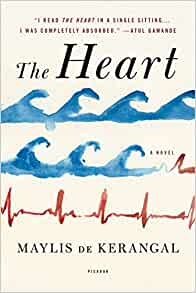Mylis de Kerangal – author
Sam Taylor – translator
New York
Picador
2017
242 pages
According to the art:
This novel is for readers who want to go deep into what people—family, organ recipients, hospital staff—experience during organ transplantation, from the time of an event making organ transplantation possible to the time a donated organ is implanted. In particular, philosophical concepts and language constraints are considered.
Synopsis:
Their analysis completed “just before midnight,” nineteen-year-old Simon Limbres and his two surfing buddies, Chris and Johan, agree they will rise at 5:50 am and head to the beach for “a mid-tide session, the kind you get only two or three times a year: heavy sea, regular swell, low wind, and not a soul around.” (p. 6) Freezing February conditions, beckoning girlfriends, and scolding parents, are not enough to keep the three surfers from the waves expected to crash upon the beach at Les Petite Dalle on the English Channel. They pile into Chris’ van stuffed with surfing equipment and make the ninety-minute drive from Le Havre through an icy drizzle.
They were not disappointed—“shit man that was awesome.” The three “Big Wave hunters” were exhilarated after an hour of “exhausting their bodies, giving them no respite,” and leaving them “worn out, spent shells, legs like jelly, staggering as they crossed the beach back to the parking lot, and back to the van.” (pp. 13-14) But as their exhilaration waned during the drive home, so too did their wakefulness, even as they sat next to each other, three across in the front seat. Rendered unmanned with three sleeping passengers, the van speeded off the road and straight into a poll. Simon, sitting in the middle seat, the only one without a seat belt, crashed through the windshield headfirst. He was found unconscious; his heart still beating. It was 9:20 am.
From this point on, starting at page eighteen, the story shifts from Simon’s life to his beating heart’s life over the next twenty hours and thirty minutes. The scenes shift from the beach to the hospital and organ transplant network. And the main characters shift from Simon and his surfing mates to primarily Simon’s parents (Sean and Marianne), Simon’s girlfriend (Juliette), an intensive care unit doctor (Pierre Révol), a transplant coordinator (Thomas Rémige), a nurse (Cordélia Owl), and a transplant candidate (Claire Méjan). The drama driving the novel is mostly around the decision Simon’s parents make about whether his heart (and other organs) can be donated for transplantation, and then the actions that follow. Some of these characters offer their own dramas: Sean and Marianne’s marital tension; Cordélia’s unrequited lust; Thomas’ competing interest in singing; and Claire’s race against time for a new heart. All these intertwine over the twenty-four hours the novel covers.
Analysis:
Well into the twenty-first century, the sequence of events comprising organ transplantation are known to the general public—procuring and preserving the organ, transporting the organ, and then implanting the organ into a recipient. We see these processes in mainstream news reports, documentaries, movies, and novels like this one. Organ transplantation is dramatic and miraculous to be sure, yet almost banal in a way with its quotidian nature—it takes place every day all over the country and throughout the western industrialized world. The author, Maylis de Kerangal, knows this. While her plot centers on a transplantation process, she dwells less on the operational elements and more on emotional turmoil the processes cause families, and on philosophical concepts and language constraints imposed on both families and health care professionals.
Readers, therefore, who are looking for a story concentrating on the operational drama of organ transplantation—aside from the ballet five transplant teams perform getting their donated organ in rapid succession—will get little from this novel that isn’t already available and more detailed in that respect. This novel is for readers who want to go deeper into what people—family, organ recipients, hospital staff—experience during organ transplantation, from the time of an event making organ transplantation possible to the time a donated organ is implanted. That’s quite a task for a writer, and requires personal experiences, a powerful imagination, and serious literary abilities. de Kerangal matches up well with these requirements and puts them all to good effect.
The motivation for de Kerangal to take on this novel, as she explained in a BBC radio interview, was the death of her father from a sudden and massive heart attack. She reports being able to see his heart fail, and then knew she had to write a novel wherein the human heart is a major character. The Heart resulted.
What must go through parents’ minds as they are asked to consider organ donation within just a few hours of their child’s death? de Kerangal recognizes they must first struggle with the question of when is a person dead. Medical resuscitation upended the long-held idea that death occurs when the heart stops, which then enabled organ transplantation. Here’s how she imagines the philosophical problem for Simon’s parents:
How could they even think about the death of their child when, what was a pure absolute—death, the purest absolute of all—had been reformulated, newly defined, in different bodily conditions? Because it was no longer that beating rhythm in the hollow of the chest that confirmed life (a soldier removing his helmet and leaning down to put an ear to the breast of his comrade lying in mud at the bottom of the trench), it was no longer breath exhaled by the mouth that signified life (a dripping lifeguard giving mouth-to-mouth to a young girl with a greenish complexion), but the electrified cerebrum, activated by brain waves, preferably beta waves. How could they even contemplate it, this death of their Simon, when his skin was still pink and soft?
p. 83
Philosophical concepts are not the only obstacles de Kerangal sees for Simon’s parents in their struggle. The language they need (and all of us need) is not available. de Kerangal explains:
How long does it take them before they accept death’s new regime? For now, there is no possible translation for what they are feeling; it strikes them down in a language that precedes language from before words, before grammar, an unshareable language that is perhaps another name for pain. Impossible to extricate themselves from it, impossible to substitute another description for it, impossible to reconstruct it in another image. They are, at once, cut off from themselves and from the world that surrounds them.
p. 84
But, de Kerangal must move them along towards accepting Simon is dead. Her formulation accounts for the element of fortune at play when she refers to this realization as “leaving the land of the innocent and…piercing the fragile membrane that separates the lucky from the damned.” (p. 70-71)
Language is also a problem bedeviling the medical team. Révol is challenged in bringing Simon’s mother along, thinking “that there is nothing as violent, as complex as this: placing himself next to this woman so that they can, together, penetrate that fragile zone of language where death is declared, so that they can move forward in synchrony.” (p. 47-48) When Rémige, the transplant coordinator, approaches Sean and Marianne about their consent for using Simon’s organs for donation, he knows the importance of the words he will choose and how he will deliver them. He even calls on his singing lessons for help.
…conscious of the fact that he is about to mistreat them, to carve into their pain with questions they know nothing about right now, asking them to think and to formulate responses when they are zombies, stunned by pain, hurtling through black space. In all probability, he prepares to speak the same way he prepares to sing, relaxing his muscles, regulating his breathing, aware that punctuation is the anatomy of language, the structure of its meaning, visualizing his opening phrase as a sound line, weighing the first syllable he will pronounce, the one that will break the silence, slicing instead of cracking the eggshell, quick and precise as a blade stroke rather than a fissure that meanders slowly up the wall when the earth trembles.
p. 97
de Kerangal avoids obvious metaphors about broken hearts, but she gestures at questions about where the soul resides, and if it resides in the heart, is a heart recipient affected? Claire, who receives Simon’s heart fears “of becoming a chimera, of no longer being herself, (p. 176) and Marianne wonders “what will become of Juliette’s love when Simon’s heart starts to beat inside a stranger’s body.” (p. 171) de Kerangal leaves her thoughts on that question for the second day.
Also:
Awards:
- Albertine Prize Finalist
- Wellcome Book Prize
- French-American Foundation Translation Prize
The title of book as originally published in France in 2014 is Réparer les vivants, and as originally published in the UK in 2016 is Mend the Living.
A movie adaptation of the novel called, Heal the Living, was released in 2016.



